- Summary
- Background
- Inspections conducted
- Deficiencies observed during inspections
- Common areas of deficiencies
- Comparison of inspection deficiencies over time
- Appendix I: Pharmacovigilance inspection topic areas
- Appendix II: Types of inspections
- Appendix III: Inspection deficiency gradings
- Appendix IV: Acronyms
- Version History
- Print version
Summary
This metrics report covers the period from 1 January 2021 to 31 December 2021. The purpose of this report is to provide a high-level overview of inspection deficiencies including a comparison of deficiencies identified in the previous reporting periods, to assist sponsors with improving their pharmacovigilance systems and preparing for pharmacovigilance inspections. All information has been de-identified.
From 1 January 2021 to 31 December 2021, the Therapeutic Goods Administration (TGA) conducted a total of nine pharmacovigilance inspections of Australian medicine sponsors as part of its Pharmacovigilance Inspection Program (PVIP).
One for-cause inspection and eight routine systems-related pharmacovigilance inspections were completed in 2021. Inspections identified:
- 3 critical deficiencies
- 37 major deficiencies
- 15 minor deficiencies.
The number and grading of deficiencies by pharmacovigilance topic area is described in Table 1 (see Appendix I for more detail on each pharmacovigilance topic area). A Corrective and Preventative Action (CAPA) plan was developed by sponsors for all identified deficiencies and all deficiencies have either been rectified or are in the process of being resolved.
| Topic area | Critical (3) | Major (37) | Minor (15) | Total by topic area (55) |
|---|---|---|---|---|
| Collection and collation of adverse drug reactions | 2 | 3 | 4 | 9 |
| Management of adverse drug reactions | - | 1 | 4 | 5 |
| Reporting adverse drug reactions | - | 5 | 1 | 6 |
| Ongoing safety evaluation | - | 1 | 1 | 2 |
| Management of significant safety issues | - | 7 | - | 7 |
| Management of reference safety information | - | 8 | - | 8 |
| Post-approval commitments | - | 6 | 1 | 7 |
| Quality management system | - | 5 | 4 | 9 |
| Australian Pharmacovigilance Contact Person (A-PVCP) & Qualified Person Responsible for Pharmacovigilance in Australia (QPPVA) | 1 | 1 | - | 2 |
The deficiencies outlined in Table 1 are combined with deficiencies previously identified through the PVIP in Figure 1 to summarise all inspection deficiencies since the commencement of the PVIP to 31 December 2021 by topic area.
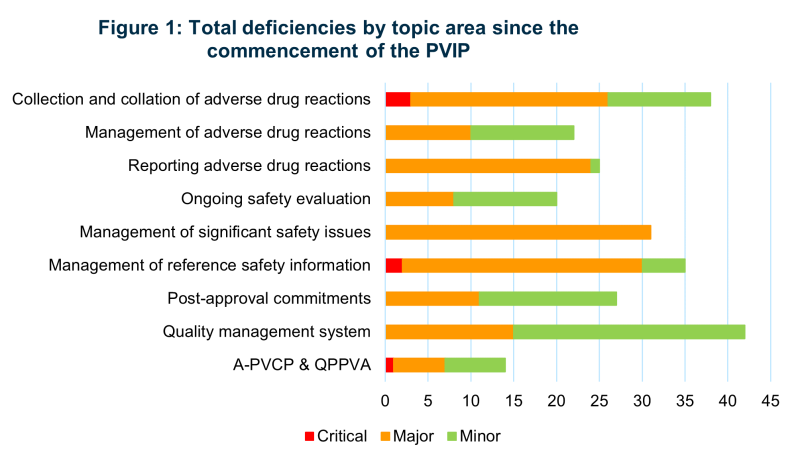
Over time, the topic areas of quality management system (17% of all deficiencies), followed by collection and collation of adverse drug reactions (15% of all deficiencies) followed by management of reference safety information (14% of all deficiencies) have represented the highest proportion of deficiencies regardless of grading. These three topic areas also had the highest proportion of total deficiencies in the current reporting period as shown in Table 1.
Deficiencies identified in the current reporting period are discussed in more detail in this report (refer to the Deficiencies observed during inspections and Common areas of deficiencies sections) and a more detailed review of cumulative inspection outcomes is provided in the Comparison of inspection deficiencies over time section of this report.
Background
The TGA’s PVIP commenced on 1 September 2017 and the first inspection was conducted in January 2018.
The PVIP aims to strengthen and broaden the TGA’s post-market monitoring activities and protect public health by ensuring the continued safety of medicines included on the Australian Register of Therapeutic Goods (ARTG).
Pharmacovigilance inspections allow the TGA to help sponsors meet their pharmacovigilance obligations and maintain effective and robust pharmacovigilance systems. The inspections assess the sponsor's compliance with currently applicable Australian pharmacovigilance regulations and guidelines, in particular the:
- Therapeutic Goods Act 1989 - external site (section 28(5e), 28(5)(ca), 28(2B), 28(3), 29A and 29AA)
- Therapeutic Goods Regulations 1990 - external site (Regulation 15A)
- Pharmacovigilance responsibilities of medicine sponsors Australian recommendations and requirements (v2.2, January 2021) (Pharmacovigilance Guidelines)
- Conditions - standard and specific, applying to registered or listed therapeutic goods (section 28 of the Therapeutic Goods Act 1989 - external site).
In 2021 the PVIP started differentiating the scope of routine inspections as either targeted or comprehensive inspections. Targeted scope inspections were conducted for the first time in 2021 and focus on a review of the local pharmacovigilance system implemented by the sponsor. Comprehensive scope inspections follow the previous approach to inspections, which includes a review of local systems and those undertaken by overseas companies and counterparts. This approach will be continued in 2022.
The decision to implement targeted or comprehensive scope inspections was to better align with the risk-based approach that the TGA takes to scheduling pharmacovigilance inspections. Risk factors that are considered include the sponsor’s products, their pharmacovigilance system, their compliance history and their recent history of inspections by Comparable Overseas Regulators (CORs). The TGA also uses the biennial PVIP Risk Assessment Survey to help plan and schedule inspections. The PVIP Risk Assessment Survey has been released to sponsors again in 2022 and sponsors have been reminded that non-completion of this survey results in assignment of the highest risk score.
Further information about the PVIP, including how the TGA prioritises inspections and our approach to pharmacovigilance compliance and enforcement, can be found in the Pharmacovigilance inspection program: Guidance for medicine sponsors.
Inspections conducted
From 1 January 2021 to 31 December 2021, the TGA conducted nine pharmacovigilance system-related inspections of Australian medicine sponsors. Eight inspections were routine inspections and there was one for-cause inspection (see Appendix II for types of inspections). There were no re-inspections, and all inspections were announced.
Six of the eight routine pharmacovigilance inspections were targeted in scope and focussed on a review of the local pharmacovigilance system implemented by the sponsor. The other two routine pharmacovigilance inspections were comprehensive in scope.
All nine inspections were conducted remotely via video conference, with no TGA inspectors attending company premises in person. Inspection duration ranged from three to five business days.
A variety of medicine sponsors were inspected during this period, including large and small innovator companies, as well as sponsors of generic medicines, over-the-counter and complementary medicines. Deficiencies were identified in all nine inspections and all inspected sponsors received at least two major deficiencies.
Deficiencies identified during inspections were graded as critical, major or minor (see Appendix III for definitions of inspection gradings). Observations are not discussed in this report. From the nine pharmacovigilance inspections conducted during the reporting period, the TGA identified:
- 3 critical deficiencies
- 37 major deficiencies
- 15 minor deficiencies
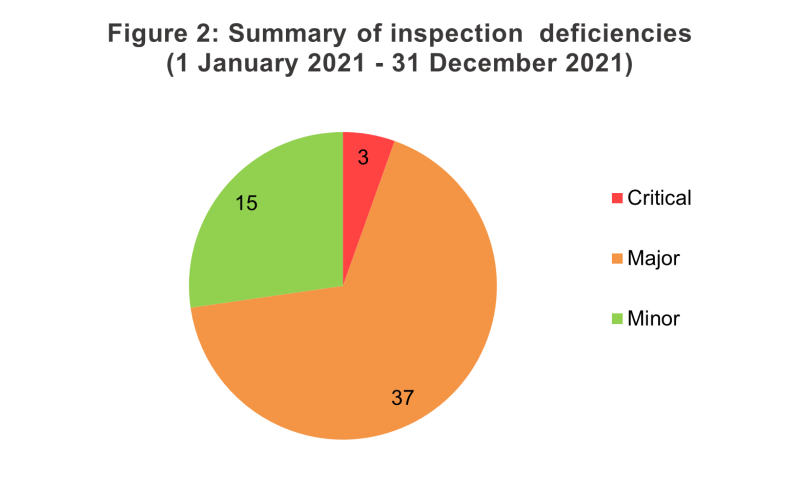
A reported deficiency may comprise multiple separate findings, grouped according to a high-level legislative requirement or according to a cumulative pharmacovigilance impact.
The deficiencies are discussed in the next section.
Deficiencies observed during inspections
Critical deficiencies
Three critical deficiencies were identified across two inspections during the reporting period.
Each of these critical deficiencies represented a serious violation of applicable pharmacovigilance legislation and guidelines or was considered to pose a potential risk to public health. Following the inspections, both sponsors developed CAPA plans, addressing the critical deficiency and proposed actions to mitigate the risk of reoccurrence. CAPA commitments are closely monitored by the TGA until they are fully implemented. Implementation of CAPA commitments for critical findings is complete for both sponsors.
The critical deficiencies were categorised under the pharmacovigilance topic areas: collection and collation of adverse drug reactions (two out of three critical deficiencies) and A-PVCP & QPPVA (see Appendix I for more information on pharmacovigilance topic areas).
De-identified summaries of the critical findings are provided below grouped by the relevant topic area.
Collection and collation of adverse drug reactions
Both sponsors who received a critical deficiency during this reporting period had not established a local pharmacovigilance system for their medicines entered on the ARTG.
One sponsor also had a critical deficiency for the A-PVCP & QPPVA topic area.
The other sponsor was headquartered in Australia and did not set up a pharmacovigilance system facilitating collection of safety information. Despite significant sales of the sponsor’s medicines, no safety information was collected, collated, processed, recorded or reported to the TGA. There was no safety database, no medical information service and no process for management of enquiries received via phone after hours.
For the two critical deficiencies raised under this topic area, for both sponsors, deficiencies included:
- Failure to develop a process for case collection from the global medical literature and/or the local medical literature
- Company sponsored websites did not facilitate reporting of safety information
- No standard process for collection from Database of Adverse Event Notifications (DAEN)
- Delays with conducting, or failure to conduct reconciliation
- Deficiencies in the safety agreement between the sponsor and the company responsible for pharmacovigilance activities.
Other deficiencies that contributed to the overall critical deficiency in this topic area for individual sponsors, were:
- Failure to include safety reporting requirements in agreements between the sponsor and relevant business partners, including partners with a consumer-facing role
- No oversight of compliance with pharmacovigilance agreements
- Outdated contact information in medicine Australian Product Information (PI)
- Deficiencies with case collection form.
A-PVCP & QPPVA
The inspection with a critical deficiency in the topic area of A-PVCP and QPPVA involved a sponsor with an absence of any local pharmacovigilance system.
Though the sponsor had notified the TGA of an A-PVCP residing in Australia, the inspection revealed that the nominated person was in fact not, the ‘person in Australia responsible for fulfilling reporting requirements’ for the sponsors medicines, therefore it was considered that the sponsor contravened its obligation to nominate and notify the TGA of its A-PVCP.
The pharmacovigilance responsibilities of this sponsor were entirely handled by an overseas parent company and the sponsor had no substantive role in meeting any of its pharmacovigilance obligations.
It is the Australian sponsor, as the person in relation to whom the goods are entered in the Register, who is required to comply with the record-keeping and reporting obligations under section 28(5)(ca) of the Therapeutic Goods Act - external site and regulation 15A of the Therapeutic Goods Regulations - external site.
The sponsor did not possess relevant pharmacovigilance records, and consequently failed to comply with its record-keeping obligations, including the requirement that pharmacovigilance data must ‘be available from a single access point within Australia’ according to the Pharmacovigilance Guidelines.
Major and minor deficiencies
During this reporting period at least two major deficiencies were identified in every inspection and at least one minor deficiency was identified in seven of the nine inspections conducted.
A total of 37 major deficiencies were identified and the median number of major deficiencies per inspection was four (see Figure 3).
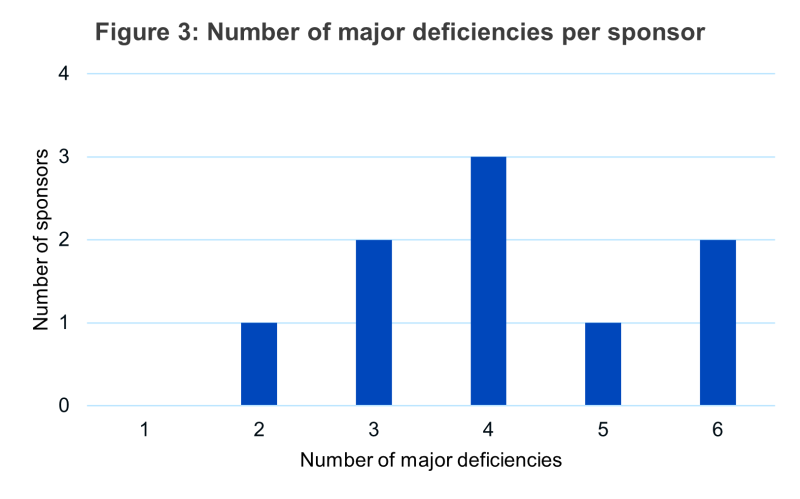
Fifteen minor deficiencies were identified from the nine inspections conducted during the reporting period and the median number of minor deficiencies per inspection was one (see Figure 4).
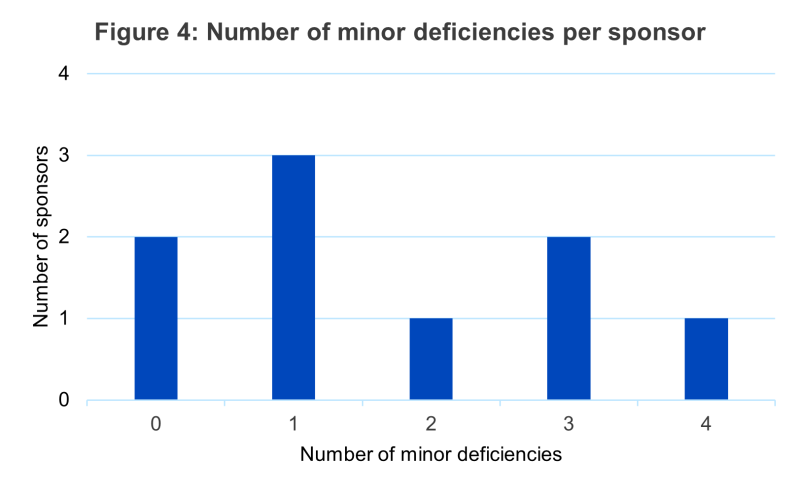
Deficiencies identified during the reporting period have been grouped by overarching topics across the pharmacovigilance system. Each topic area is also made up of various sub-topics (see Appendix I). A summary of the topic areas in which major and minor deficiencies were most frequently identified is provide in Table 2.
| Deficiency grading | Total deficiencies | Topic areas with deficiencies most frequently identified (number of inspections) |
|---|---|---|
| Major | 37 | Management of reference safety information (8) Management of significant safety issues (7) Post-approval commitments (6) |
| Minor | 15 | Collection and collation of adverse drug reactions (4) Management of adverse drug reactions (4) Quality management system (4) |
These deficiencies, along with other topic areas, are discussed in more detail in the next section, Common areas of deficiencies.
Common areas of deficiencies
In the current reporting period, the highest proportion of deficiencies regardless of grading were in relation to the collection and collation of adverse drug reactions and the quality management system topic areas.
The number and grading of all deficiencies by pharmacovigilance topic area is presented in Figure 5, followed by a detailed discussion on the aspects of non-compliance identified in inspections for each topic area.
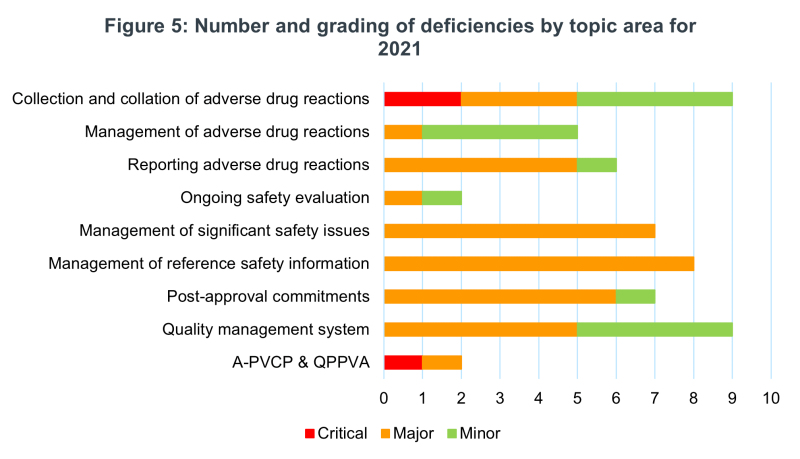
Collection and collation of adverse drug reactions
A deficiency in collection and collation of adverse drug reactions was identified in every inspection conducted during the reporting period.
Deficiencies were identified in the following processes:
- Failure to collect safety information from medical information enquiries, product quality complaints, company-sponsored websites and social media, local and international medical literature, internal company departments – including any platforms used to record interactions with customers, business partners, the TGA DAEN and post-registration programs (e.g. patient support programs, product familiarisation programs, market research programs etc.)
- Failure to include relevant safety reporting provisions in all third party contractual agreements prior to the service commencing
- Failure to reconcile safety information with all possible (relevant) sources
- Inadequate identification and collection of special situation reports e.g. off-label use, misuse and medication error
- Failure to establish access to safety data from a single access point in Australia
- Failure to collect and record patient ethnic origin and consent to follow up for additional information
- Failure to record invalid reports (drug-event pairs) in the pharmacovigilance system and perform follow up on these reports for additional information.
Sponsors should maintain a pharmacovigilance system that allows them to identify, collect and collate all information related to safety of their medicine from all possible sources. Sponsors should also exercise due diligence and develop procedures to collate accurate and complete reports of adverse drug reactions.
In accordance with the Pharmacovigilance Guidelines, pharmacovigilance data collected, collated and electronically stored must be available from a single access point within Australia. For sponsors where this pharmacovigilance data is collated in a global safety database, the QPPVA must ensure and be able to demonstrate ready access to this pharmacovigilance data.
Sponsors should collect information about patient ethnicity, including if reports pertain to patients of Aboriginal and/or Torres Strait Islander origin.
The TGA requires sponsors to collect and record invalid reports containing drug-event pairs in the sponsor safety database. Furthermore, sponsors should exercise due diligence in following up invalid reports to collect missing data elements. However, if a report cannot be validated it should be retained and recorded in your pharmacovigilance system and included in ongoing safety evaluation activities.
Quality management system
A deficiency in the quality management system of any grading was observed in all inspections conducted during the reporting period.
Pharmacovigilance procedures
All nine inspections conducted in this reporting period included a deficiency relating to pharmacovigilance procedures. Inadequacy of pharmacovigilance procedures or their management is consistently one of the most frequently cited sponsor root cause analyses for inspection deficiencies. Sponsors should establish a quality management system that supports their pharmacovigilance system to meet their Australian pharmacovigilance requirements and standard operating procedures underpin the quality management system.
Deficiencies were identified in the following aspects of sponsor pharmacovigilance procedures:
- Roles, responsibilities and timelines for all tasks that contribute to the pharmacovigilance system were not clearly defined
- Failure to retain evidence of completion of the tasks described in their standard operating procedures, as required by the sponsors pharmacovigilance record keeping obligations
- Failure to implement regular reviews of standard operating procedures
- Failure to monitor for updates to TGA requirements and recommendations or failure to monitor for updates to internal processes and assess the impact on pharmacovigilance standard operating procedures
- Failure to implement timely updates to sponsor standard operating procedures following the identification of a need for change e.g. following an audit finding
- Inadequate version control.
Agreements with third parties and sponsor oversight of third parties
All nine inspections conducted in this reporting period included a deficiency relating to aspects of the pharmacovigilance system involving a third party and specifically involved deficiencies with the content of the executed agreement or the sponsor oversight in place, such as:
- Failure to include appropriate pharmacovigilance requirements in all relevant third party agreements
- Failure to implement pharmacovigilance requirements in a timely manner upon engagement with these companies
- Failure to maintain agreements, including for example, up to date sponsor contact details and alignment of clauses with any updates to the sponsor or the TGA requirements
- Failure to include provisions in agreements for ongoing oversight of external companies and their compliance with pharmacovigilance requirements e.g. via audit or other quality assurance methods
- Lack of evidence of oversight.
The agreements reviewed during the inspection reporting period involved third parties undertaking pharmacovigilance activities on behalf of the sponsor, or activities with an impact or potential impact on the pharmacovigilance system e.g. patient support programs.
Pharmacovigilance training
A deficiency in pharmacovigilance training was identified in eight out of nine inspections conducted during this reporting period.
Pharmacovigilance awareness training should be conducted for all company personnel at induction of employment, preferably within the first month, with an annual refresher at a minimum for all relevant staff. Delays in receipt of the initial company pharmacovigilance training were identified as well as omissions in the training of contractors.
Sponsors are recommended to include an assessment following the pharmacovigilance awareness training and set the passing score to 100% to verify that company personnel have a thorough understanding of their pharmacovigilance obligations. A deficiency in the assessment of knowledge following pharmacovigilance training was identified in six out of nine inspections during this reporting period.
Evidence of further training on pharmacovigilance, including pharmacovigilance procedures is reviewed as part of the inspection process and the following deficiencies were identified during this reporting period:
- Training on new or revised procedures was not scheduled or did not occur prior to the procedure becoming effective
- Delays in the completion of training on pharmacovigilance procedures by staff undertaking pharmacovigilance activities
- No record of training on the relevant TGA pharmacovigilance guidance documents by the QPPVA.
Furthermore, there were examples in this reporting period of the sponsor following processes that had not been documented in a written procedure. No associated training records were available and it was not possible to verify that the process was conducted in a systematic way or that staff undertaking these processes understood the requirements of those tasks.
Pharmacovigilance record-keeping
A deficiency in pharmacovigilance record-keeping was observed in seven out of nine inspections conducted during this reporting period.
Under paragraph section 28(5)(ca) of the Therapeutic Goods Act 1989 - external site, records pertaining to the reporting requirements and safety for your medicine(s) must be retained for the life of the medicine and for an additional 5 or 10 years after removal from the ARTG for listed and registered medicines respectively. These timelines are set out in the Pharmacovigilance Guidelines alongside further information about the types of pharmacovigilance records that sponsors must consider.
As a part of the quality management system, sponsors should identify all records that are relevant to their pharmacovigilance system and clearly document how these will be managed and retained. Pharmacovigilance records should be secured with appropriate confidentiality and accessibility controls. The record-keeping system should support the timely retrieval of pharmacovigilance records upon request by the TGA.
Sponsors are reminded that the record-keeping requirements also apply to records created and/or maintained overseas for sponsor medicines included in the ARTG.
Management of reference safety information
A deficiency related to the management of reference safety information was identified in eight out of nine inspections conducted during the reporting period and all eight were graded as major.
To ensure the safe use of medicines, it is necessary that all reference safety information documents that are available to healthcare professionals, consumers and sponsor personnel are kept up to date. Sponsor procedures should facilitate timely submission of variations to ensure there is no undue delay in updating PI and Consumer Medicine Information (CMI) documents that are relied upon by prescribers and patients to make decisions relating to the safe and effective use of medicinal products.
Deficiencies in this topic area comprised multiple findings related to delays in updating the Australian PI, CMI, product packaging leaflets, minimum PI and related promotional material, with new or revised safety information and examples are outlined below.
Access to current reference safety information
The TGA recommends that PI and CMI are always accessed via the TGA website - external site. During the inspection reporting period, deficiencies were identified where the sponsor failed to ensure that the current PI and CMI were published on other platforms, e.g. company-owned websites, in line with the version published on the TGA website. The sponsor should be aware of all repositories used to access the PI and CMI, both internally and externally, and ensure that there is a process to ensure a minimal delay in alignment across platforms following any updates.
Deficiencies in third party access to the PI and CMI were also identified. The sponsor is responsible to ensure that any contracted third party personnel have access to the current reference safety information. Ideally this should be documented in the agreement with third parties for the avoidance of doubt, including how reference safety information will be accessed and how the third party will be informed of any important updates e.g. safety-related changes.
Timelines applicable for the maintenance of the reference safety information
Sponsors should have procedures in place to ensure compliance with regulatory timeframes and ensure appropriate quality checks, tracking and documentation.
Deficiencies with the following timelines were identified during this reporting period:
- Delayed submission to the TGA of safety-related variations to the Australian PI, beyond six months of company decision date. Sponsors are reminded to maintain the currency of the PI, irrespective of whether the product is currently supplied in Australia or whether the PI document is published on the TGA website
- Failure to lodge the updated PI on the TGA eBS within two weeks of the TGA approval of the safety related variation
- Failure to lodge the updated CMI on the TGA eBS within two weeks of the TGA approval of the TGA approval of the safety related variation/PI.
In addition, it is expected that sponsors hold evidence of the CMI impact assessment, which documents the timely decision about whether a CMI revision is warranted following a safety related variation. Deficiencies were identified when sponsors could not provide such evidence.
Standard procedures following safety-related variations
The following deficiencies were identified in relation to procedures after the TGA approval of a revised PI:
- Failure to communicate changes and availability of updated reference safety information to relevant staff and third parties
- Failure to conduct a timely impact assessment and make necessary updates to all associated company-sponsored material, such as educational and promotional materials, or internal reference documents, manuals, and materials used by medical information staff to respond to medical enquiries
- Failure to maintain consistency of the Minimum (abridged) PI with the PI.
Updating reference safety information for the generic medicines
Sponsors of generic medicines must comply with the condition of registration to align PI and CMI within one month of a safety-related update to the innovator’s PI when this condition is imposed by the TGA.
Delays of up to 323 days beyond the one-month timeline were identified through inspection in the current reporting period.
Sponsor procedures should describe a process for identification of the innovator product and routine review of the innovator PI on the TGA website to identify safety-related updates. Furthermore, the timeframe for this review must enable compliance for the timing of the subsequent submission to the TGA of any required variations to the generic medicine PI.
Management of significant safety issues
A deficiency in the management of significant safety issues was identified in seven out of nine inspections conducted during the reporting period. All seven deficiencies were graded as major.
Deficiencies in this topic area comprised multiple findings related to the:
- Failure to identify significant safety issues
- Failure to report significant safety issues to the TGA within 72 hours of first (local) awareness
- Delayed communication of safety issues to the sponsor, including those identified internally and safety-related actions taken by Comparable Overseas Regulators (CORs)
- Failure to develop standard procedures for the management of significant safety issues including the documentation of decisions relating to significant safety issue notification.
Delays in the receipt of information about potential significant safety issues from a parent/global organisation are considered unacceptable and a risk to public health.
Sponsors should have robust procedures in place to ensure that internally validated signals and suspected or confirmed medicine quality defects are promptly received and assessed against the Pharmacovigilance Guidelines.
The TGA also considers significant safety issues to include safety-related actions taken by CORs. Therefore, sponsors should have procedures in place to ensure their awareness of such safety-related actions. This may include regularly screening safety-related information published by CORs and ensuring that any COR requests for safety-related actions are sent to the sponsor in a timely manner.
Sponsors are reminded that third party contractual agreements should include relevant safety reporting provisions that outline responsibilities related to the identification, management and reporting of significant safety issues.
Post-approval commitments
A deficiency in compliance with post-approval commitments was identified in seven out of nine inspections conducted during the reporting period, comprising six major deficiencies and one minor deficiency.
Deficiencies identified in this topic area included:
- Failure to access all approval letters and section 28 letters applicable to products on the ARTG and implement a process to verify ongoing compliance with the conditions imposed
- Delays in PSUR submission
- Failure to implement the correct reporting period and/or submission frequency of Periodic Safety Update Reports (PSURs)
- Failure to notify, or delayed notification to, the TGA of the commencement of supply
- Delays in the submission of an updated Risk Management Plan (RMP) / Australian Specific Annex (ASA) to the TGA
- Failure to notify the TGA regarding an intended significant change to the RMP-ASA (e.g. cessation of an additional risk minimisation activity) before the change was implemented.
Sponsors must comply with all conditions of registration as set out in the approval letter or any subsequent amendments and compliance will be assessed in an inspection. Conditions of registration relevant to the pharmacovigilance system may include, but are not limited to, the notification of commencement of supply, implementation of the Black Triangle Scheme requirements, preparation, and timely submission of PSURs, maintenance of RMPs and ASAs and compliance with RMP commitments.
In the event that sponsorship of a medicine was transferred, the current sponsor is expected to have access to the original TGA approval letter(s) for complete oversight of conditions of registration relating to pharmacovigilance. Further information regarding the obligations of a new sponsor, including record keeping, can be found on the TGA website.
Company procedures should require prompt communication of RMP updates between global staff and the sponsor to ensure that the RMP-ASA is maintained and submitted to the TGA in a timely manner.
Reporting adverse drug reactions
A deficiency in reporting adverse drug reactions to the TGA was identified in six out of nine inspections conducted during the reporting period. Five of those six deficiencies were graded as major. All six deficiencies included examples of a failure to report and/or delayed reports of serious adverse reaction reports to the TGA.
Sponsors are reminded that all serious adverse drug reactions must be reported to the TGA within 15 calendar days of first receipt by any company personnel. Sponsors should ensure that robust procedures are in place to facilitate prompt reporting of all safety information from all sources, to achieve compliance with the 15-day reporting timeframe.
Where sponsors rely on automated reporting rules, it is important to verify the compliance of those against the legislative requirements for Australia. Furthermore, where E2B reporting has been implemented, the sponsor needs to retain appropriate oversight of report submissions.
The QPPVA is expected to demonstrate awareness of any late reports. The sponsor is expected to investigate any known incidences of late reports to identify the required improvements to the pharmacovigilance system.
Management of adverse drug reactions
Deficiencies in the management of adverse drug reactions were identified in five out of nine inspections conducted during the reporting period comprising one major deficiency and four minor deficiencies.
Deficiencies in this area have potential impact on serious adverse drug reaction reporting to the TGA and ongoing safety evaluation activities.
Deficiencies were identified in the following areas:
- Failure to retain source documents
- Inadequate quality assurance process prior to case transmission to the global team for processing
- Inconsistencies or failures to perform causality and expectedness assessments of Australian reports as recommended in the Pharmacovigilance Guidelines or outlined in sponsor procedures
- Lack of local oversight of solicited information arising from Australian post-authorisation programs
- Failure to identify special situation reports
- Deletion of a valid case of a special situation report from the global safety database
- Incorrect classification of lack of efficacy reports
- Failure to develop a process for management of voicemail as a source document
- Lack of follow‐up on adverse drug reaction and invalid reports, including from social media and with consumers
- Failure to provide safety database case records during inspection.
Sponsors are reminded that the TGA expects sponsors to make reasonable effort to follow up, where possible, on all adverse events received to obtain missing information, validate the case and obtain detailed supplementary information significant to the clinical evaluation (i.e. seriousness and causality) of the case.
Sponsors must record all reports of overdose, abuse, off-label use, misuse, medication error or occupational exposure and include these reports in ongoing monitoring, even if there is no association with an adverse event.
A-PVCP & QPPVA
A deficiency of any grading related to the A-PVCP and QPPVA topic area was identified in two out of nine inspections conducted during the reporting period. Specifically, one critical deficiency (see section Critical Deficiencies) and one major deficiency were identified for this topic area. Deficiencies related to the A-PVCP and QPPVA were also identified in three other inspections but categorised under different topic areas.
Deficiencies in this topic area were related to:
- Failure to notify the TGA of the name and contact details of the A-PVCP within 15 calendar days of the first medicine’s entry on the ARTG
- Failure to notify the TGA of updates to the name and contact details of the A-PVCP within 15 calendar days
- Failure to demonstrate availability of QPPVA
- Failure to identify a back-up QPPVA to ensure business continuity
- Inadequate oversight of the pharmacovigilance system by the QPPVA
- False or misleading notification of A-PVCP to the TGA.
Sponsors are reminded that they must nominate an A-PVCP who will be responsible for fulfilling their pharmacovigilance reporting requirements. The nominated A-PVCP must reside in Australia and should have a sound understanding of Australian pharmacovigilance reporting requirements. The A-PVCP should be nominated, or their details updated, through the TGA eBS. Any changes to the A-PVCP or their details must be notified within 15 calendar days. Evidence to demonstrate compliance with these reporting requirements should be available during an inspection and retained in accordance with your pharmacovigilance record-keeping requirements.
The QPPVA should ensure that the sponsor has an effective pharmacovigilance system in place to comply with Australian pharmacovigilance requirements. The sponsor should be able to provide evidence of how the QPPVA achieves ongoing oversight of the pharmacovigilance system and how the effectiveness of the pharmacovigilance system is measured.
In accordance with the Pharmacovigilance Guidelines, the TGA recommends that the QPPVA is permanently and continuously available (or at least within the hours of 9am–5pm AEST Monday to Friday) with a back-up person nominated, should the primary QPPVA be absent.
Ongoing safety evaluation
A deficiency of any grading in ongoing safety evaluation was identified in two out of nine inspections conducted during the reporting period. Specifically, one major deficiency and one minor deficiency were identified for this topic area.
The deficiencies involved:
- Inability to access safety information originating from Australia. Safety information must via a single access point, within Australia, for the purpose of ongoing safety evaluation and oversight. This requirement includes Australian safety data initially collected by the company overseas, e.g. via international literature search.
- Issues in the methodology for safety evaluation and timelines for management of the output of safety evaluation activities.
Safety monitoring activities should include a review of cumulative cases, in order to allow for a comprehensive review of potential safety issues. Furthermore, sponsors should have a process in place to describe the methodology of detection and investigation of such issues in a timely manner. Where safety monitoring activities are conducted by a parent company or by a third party or partner, the sponsor and specifically the QPPVA, needs to have adequate understanding of the processes in order to allow them to have effective oversight of the entire pharmacovigilance system.
Comparison of inspection deficiencies over time
From the commencement of the PVIP, on 1 September 2017, to 31 December 2021, the TGA has conducted 35 pharmacovigilance inspections of Australian medicine sponsors. A breakdown of inspections conducted per reporting period is presented in Table 3.
| Inspection period | Number of inspections conducted (35) | Average number of deficiencies per inspection (all gradings) | Average number of critical deficiencies per inspection | Average number of major deficiencies per inspection | Average number of minor deficiencies per inspection |
01-Sep-17 to 31-Dec-18 | 10 | 7.7 | 0 | 5 | 2.7 |
01-Jan-19 to 31-Dec-19 | 10 | 7.7 | 0.1 | 4.2 | 3.4 |
01-Jan-20 to 31-Dec-20* | 6 | 7.5 | 0.3 | 4.5 | 2.7 |
01-Jan-21 to 31-Dec-21 | 9 | 6.1 | 0.3 | 4.1 | 1.7 |
* Fewer inspections were conducted in 2020 as a result of a four-month pause on inspections in response to the COVID-19 pandemic.
The average number of inspection deficiencies (regardless of grading) per inspection continued to decrease in the current reporting period and this was reflected in a decrease in the average number of major and minor deficiencies per inspection. This could be partially attributed to a changed inspection reporting format across these reporting periods, with an increased focus on consistently grouping deficiencies according to a high-level legislative requirement or according to a cumulative pharmacovigilance impact. However, direct comparisons across individual reporting periods may not be meaningful as the type of sponsors inspected in each reporting period varies.
Major deficiencies continued to constitute the largest proportion of deficiencies by grading, across all inspection reporting periods. All inspections to date have resulted in at least two major deficiencies.
Inspection deficiency topic areas
The number and distribution of all critical, major and minor deficiencies across inspection topic areas since the commencement of the PVIP are shown in Figure 6, 7 and 8, respectively. Case collection and collation is the topic area for which the largest number of critical deficiencies have been identified over time.
Management of significant safety issues remains the topic area for which the largest number of major findings has been reported since the commencement of the PVIP. This is closely followed by management of reference safety information, which also had the highest number of major deficiencies in the current reporting period.
The number of major deficiencies identified in the post-approval commitments topic area substantially increased in the current reporting period from one major deficiency in 2020 to six major deficiencies in 2021. This was accompanied by a decrease in minor deficiencies identified in this topic area, as shown in Figure 8, indicating that more serious examples of non-compliance were identified in this topic area in comparison to previous years.
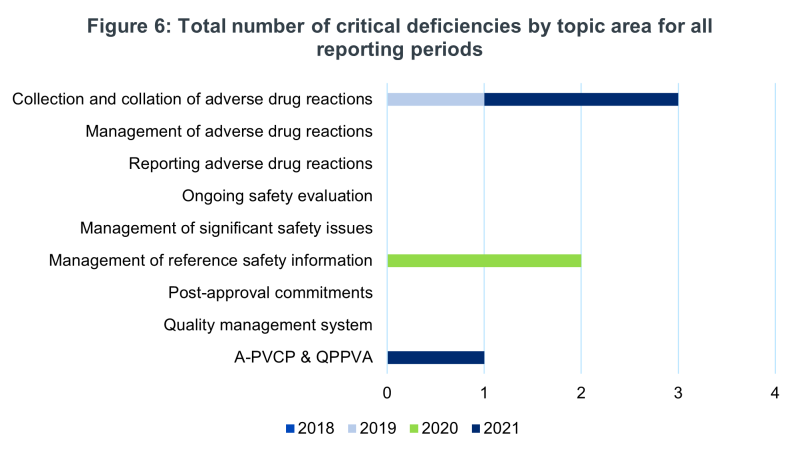


Appendix I: Pharmacovigilance inspection topic areas
Topic area | Sub-topic |
|---|---|
| Collection and collation of adverse drug reactions | Spontaneous sources of safety data, including medical information, product quality complaints, medical literature, company personnel (e.g. sales representatives, social/digital media etc.) |
| Solicited sources of safety data, including patient support or market research programs, post-registration studies etc. | |
| Safety data exchange agreements, pharmacovigilance agreements and pharmacovigilance clauses in other agreements* | |
| Management of adverse drug reactions | Case processing, including data entry, quality control and assurance, coding, causality and seriousness assessment, and follow-up and management of invalid and special situation reports |
| Reporting adverse drug reactions | Reporting serious adverse drug reactions within 15 calendar days |
| Ongoing safety evaluation | Signal detection and management |
| Production of PSURs | |
| Management of significant safety issues | Identifying significant safety issues |
| Recording of assessment of safety issues as significant safety issues or the decision not to notify the safety information as a significant safety issue | |
| Reporting significant safety issues within 72 hours | |
| Management of reference safety information | Maintenance of core safety information (if applicable) |
| Maintenance of Australian PI, CMI, product packaging leaflets and product labelling | |
| Maintenance of safety-related information in company-sponsored material (e.g. educational or promotional items) | |
| Communication of updated safety-related information to internal and external stakeholders | |
| Post-approval commitments | Submission of PSURs |
| Maintenance and submission of RMPs/ASAs | |
| Compliance with RMP commitments | |
| Oversight of and compliance with other pharmacovigilance related conditions of registration | |
| Quality management system | Management and retention of pharmacovigilance records |
| Pharmacovigilance training | |
| Management of pharmacovigilance procedures | |
| Audit and deviation management | |
| Safety data exchange agreements, pharmacovigilance agreements and pharmacovigilance clauses in other agreements* | |
| Oversight of vendors | |
| Australian Pharmacovigilance Contact Person (A-PVCP) & Qualified Person Responsible for Pharmacovigilance in Australia (QPPVA) | Notification of the A-PVCP including updates within 15 calendar days |
| QPPVA oversight of the pharmacovigilance system including involvement and awareness of product-specific issues |
* this sub-topic may instead be categorised under the Quality management system topic area, depending on the specific nature of the non-compliance identified in the inspection.
Appendix II: Types of inspections
Excerpt from pages 10-11 of the Pharmacovigilance inspection program: Guidance for medicine sponsors
Please note the TGA is referred to as ‘we’ or ‘us’, and sponsors as ‘you’.
Routine inspections
Routine pharmacovigilance inspections are scheduled as part of the inspection program. There is no specific trigger for these inspections, although we take a risk-based approach to prioritising them. These inspections are usually system-related inspections, but one or more products may be selected as examples to verify the implementation of the system and provide practical evidence of its functioning and compliance.
‘For cause’ inspections
‘For cause’ inspections are undertaken in response to specific triggers where a pharmacovigilance inspection is the appropriate way to examine the issues. ‘For cause’ inspections generally focus on specific aspects of the sponsor’s pharmacovigilance system or examine identified compliance issues and their impact on a specific product. However, we may also inspect the sponsor’s entire pharmacovigilance system as a result of a trigger. Significant public health concerns or identified noncompliance are expected to be the most common triggers.
System-related inspections
Pharmacovigilance system-related inspections review the procedures, systems, personnel and facilities in place and determine whether your system meets your regulatory pharmacovigilance obligations. As part of this review, product-specific examples may be used to determine how the pharmacovigilance system operates and whether it complies with requirements.
Product-related inspections
Product-related pharmacovigilance inspections primarily focus on product-related pharmacovigilance issues, including product-specific activities and documentation, rather than reviewing the system overall. They are likely to be ‘for cause’ inspections to investigate a specific product issue. Some aspects of the wider system may be examined during a product-related inspection (that is, the system used for that product).
Announced and unannounced inspections
We anticipate the majority of inspections will be announced - that is, we will notify you of them in advance to ensure the relevant personnel will be available for the inspection. However, it may sometimes be appropriate to conduct unannounced inspections or to perform an inspection at short notice (for example, when an announcement could compromise the objectives of the inspection or when prompt inspection is required due to urgent public health concerns).
Re-inspections
We may re-inspect the sponsor’s pharmacovigilance system as part of our routine inspection program. We prioritise re-inspections by assessing risk factors. If a previous inspection identified a high level of compliance this may increase the time between re-inspections. More frequent re-inspections may occur:
- where we have identified significant noncompliance
- to verify sponsors have taken action to address deficiencies observed during inspection
- to evaluate the sponsor’s ongoing compliance with their obligations and evaluate changes to their pharmacovigilance system
- when a previous inspection finds a sponsor had failed to take appropriate corrective and preventative action in response to prior inspections.
Remote inspections
These are pharmacovigilance inspections of the sponsor’s premises (or the premises of a firm contracted to help fulfil the sponsor’s pharmacovigilance activities) that we perform remotely using communication technology such as the internet or video/tele conferencing. If the remote inspection reveals issues that require onsite inspection, or the inspection objectives could not be met remotely, we may visit the inspection site.
Appendix III: Inspection deficiency gradings
Excerpt from page 21 of the Pharmacovigilance inspection program: Guidance for medicine sponsors
Critical deficiency:
A deficiency in pharmacovigilance systems, practices or processes that adversely affects the rights, safety or well-being of patients or that poses a potential risk to public health or that represents a serious violation of applicable legislation and guidelines.
Deficiencies classified as critical may include a pattern of deviations classified as major.
A critical deficiency also occurs when a sponsor is observed to have engaged in fraud, misrepresentation or falsification of data.
Major deficiency:
A deficiency in pharmacovigilance systems, practices or processes that could potentially adversely affect the rights, safety or well-being of patients or that could potentially pose a risk to public health or that represents a violation of applicable legislation and guidelines.
Deficiencies classified as major may include a pattern of deviations classified as minor.
Minor deficiency:
A deficiency in pharmacovigilance systems, practices or processes that would not be expected to adversely affect the rights, safety or well-being of patients.
A deficiency may be minor either because it is judged as minor or because there is insufficient information to classify it as major or critical.
Note:
- Deficiencies are classified by the assessed risk level and may vary depending on the nature of medicine. In some circumstances an otherwise major deficiency may be categorised as critical.
- A deficiency reported after a previous inspection and not corrected may be given higher classification.
- Observations may be included in the inspection report and are not discussed here in this Metrics Report. Observations are not deficiencies but might lead to suggestions on how to improve quality or reduce the potential for a deviation to occur in the future.
Appendix IV: Acronyms
| Acronym | Full term |
|---|---|
| A-PVCP | Australian Pharmacovigilance Contact Person |
| ARTG | Australian Register of Therapeutic Goods |
| ASA | Australian Specific Annex |
| CAPA | Corrective and Preventative Action |
| CMI | Consumer Medicine Information |
| COR | Comparable Overseas Regulator |
| DAEN | Database of Adverse Event Notifications |
| PI | Product Information |
| PSUR | Periodic Safety Update Report |
| PVIP | Pharmacovigilance Inspection Program |
| QPPVA | Qualified Person for Pharmacovigilance in Australia |
| RMP | Risk Management Plan |
| TGA | Therapeutic Goods Administration |
| TGA eBS | eBusiness Services System |



